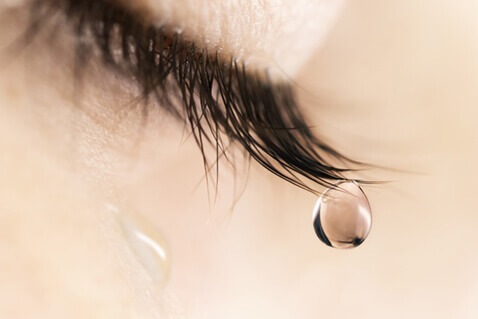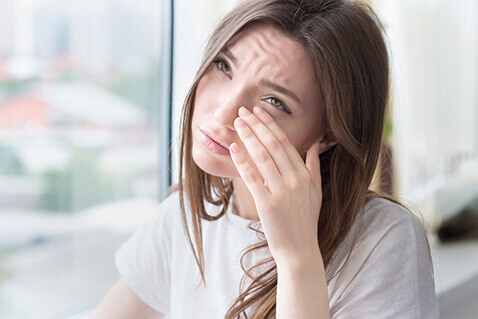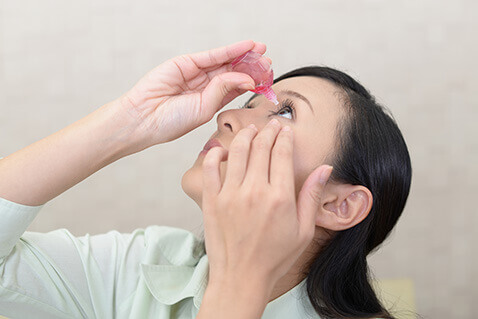Learn About Dry Eyes

What is a tear?
A tear is a mix of:
- Water and salts, for moisture
- Oils, for lubrication and to reduce evaporation
- Mucus, for adherence to the eye surface
- Antibodies and proteins to prevent infection
What are the symptoms of dry eye?
Dry eye symptoms may include any of the following:
- Stinging or burning of the eye
- A sandy or gritty feeling as if something is in the eye
- A stringy discharge from the eye
- Pain and redness of the eye
- Inability to cry when emotionally stressed
- Uncomfortable contact lenses
- Decreased tolerance of reading, working on the computer, or any activity that requires sustained visual attention
- Eye fatigue
- Episodes of blurred vision
Excessive Tearing
Sometimes, dry eyes create too many tears. This confusing condition is called reflex tearing. It happens because the lack of moisture irritates your eye. This sends a distress signal through your eye nerves asking for more lubrication. Your body sends a flood of tears to try to protect your eyes, much as when you get sand in your eye, and it runs. But these tears are mostly water, so they can help wash away debris, but they can’t coat your eye surface like regular tears. Excessive tearing can also result from an imbalance between tear production and tear drainage. Excess tear production often results from dry eye and/or unhealthy tear film. It can also result from insufficient due to narrowing or obstruction along the lacrimal pathway, starting from the eyelid and ending in the nose (the nasolacrimal duct). Non-invasive in-office evaluation can localize the problem. When a blockage is present, surgical treatments ranging from widening of the tear ducts to endoscopic nasal surgery can offer improvement.

Causes and Risk Factors
What are the causes of dry eye?
Dry eye can be a temporary or chronic condition. It can be caused by:
- A side effect of medications, including antihistamines, nasal decongestants, tranquilizers, certain blood pressure medicines, Parkinson’s medications, birth control pills and anti-depressants
- Inflammation of the glands in the eyelids, known as blepharitis
- Pregnancy
- The natural aging process, especially menopause
- Allergies
- Infrequent blinking, associated with staring at computer, prolonged reading or driving
- Both excessive and insufficient dosages of vitamins
- Homeopathic remedies may have an adverse impact on a dry eye condition
- Loss of sensation in the cornea from long-term contact lens wear
- Immune system disorders such as Sjögren’s syndrome, lupus, and rheumatoid arthritis
- Exposure to irritants such as chemical fumes and tobacco smoke, or drafts from air conditioning or heating.
- Conditions in which the surface of the eye is exposed more, such as thyroid disease when the eye protrudes forward or after cosmetic eyelid surgery, if the eyelids are opened too widely
How is dry eye treated?
Our doctors will first determine the cause of your symptoms. Once the diagnosis is made, there are several approaches to relieve the symptoms.
Prevention
If dry eye results from taking a medication, your doctor may recommend switching to a medication that does not cause the dry eye side effect. If contact lens wear is the problem, your eye care practitioner may recommend another type of lens or reducing the number of hours you wear your lenses. In the case of severe dry eye, you may be advised not to wear contact lenses at all.
Changes in your environment can be very helpful:
- In dry climates, a humidifier can reduce symptoms.
- Lowering the height of your computer monitor will reduce eye surface exposure.
- Avoid direct exposure to heating or air conditioning vents, and take a break every twenty minutes from reading, or staring at a computer.
Ocular Lubricants and Ointments
The most common first line of treatment is artificial tears and ointments. Most of these are available over the counter. No one product is right for everyone, so you may have to try a few to find the one that works best for you. They are available in increasing thickness, so your choice depends somewhat on the severity of your condition. Your eyes may dry out primarily when you are asleep, so you may find relief in using drops first thing upon awakening, or by using an eye ointment when you go to sleep.
Prescription Eye Drops

There are two prescription eye drops that can help boost tear production. Cyclosporine, also known as Restasis, an anti-inflammatory medication, and Lifitegrast, or Xiidra, can increase basic tear production, and reduce symptoms of dry eye. It may take two to six months of twice-a-day dosages for the medication to work. In some cases of severe dry eye, short term use of steroid eye drops that decrease inflammation is required.
Other Medications and Nutrition
Other medications can be formulated to treat persistent dry eyes. Adding fish oil or Omega-3 fatty acids to your diet can also help. The use and dosage of nutritional supplements and vitamins should be discussed with your primary medical doctor.
Punctal Plugs
There are methods that allow both natural and artificial tears to stay on your eye longer. Each eyelid has a punctum— a little opening that drain tears away from the eye. Punctal plugs are painlessly inserted into the puncta to partially or completely block the “drainpipe,” through which tears usually go from your eye into your nose, allowing more tears to be available to the eye. For people who have not found dry eye relief with drugs, punctal plugs may help.
What can I do to help myself?
- Use artificial tears, gels, gel inserts, and ointments – available over the counter – as the first line of therapy. They offer temporary relief and provide an important replacement of naturally produced tears.
- Wearing glasses or sunglasses that fit close to the face (wrap around shades) or that have side shields can help slow tear evaporation from the eye surfaces. Indoors, an air cleaner to filter dust and other particles helps prevent dry eyes. A humidifier also may help by adding moisture to the air.
- The use and dosage of nutritional supplements and vitamins should be discussed with your primary medical doctor.
- Avoid dry conditions and allow your eyes to rest when performing activities that require you to use your eyes for long periods of time.
If, despite these measures, you still have symptoms, please make an appointment with our office to further explore potential causes and treatment options.
